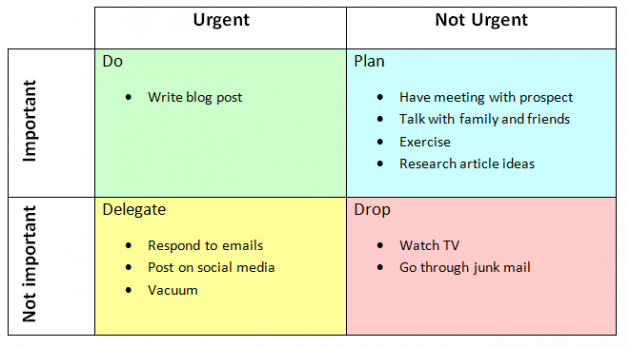
People like creating to-do lists. It makes them feel productive and useful, as each completed task gets a well-deserved check mark beside it.
In theory, all the tasks on a daily list get completed. Then, you can sit back on your couch and congratulate yourself for finishing a hard day's work.
But in practice, it can leave you feeling stressed and not very
productive after all. Here's the problem with creating lists: there's no
priority in sequence.
For example, let's take a look at a list of things I want to do today:
- Write article
- Have meeting with prospect
- Talk with family and friends
- Check email
- Exercise
- Research article ideas
- Share posts on social media
- Vacuum
- Catch up on Better Call Saul
Phew, that's a lot of ground to cover in a day. Don't you think?
In a to-do list, our goal is to get rid of the pending tasks as
soon as possible. The fastest way is to do the easiest tasks first, such
as check email, tweet posts, and watch a TV episode while doing the
first two.
Except, by doing this you would never get around to the
important tasks. You would feel exhausted mentally halfway through and
probably run out of time.
Instead, I suggest sorting out the tasks in order of importance. One useful tool for doing so is the Eisenhower Matrix.
The principle behind the Eisenhower Matrix is that we should
separate tasks that are important from those that are urgent. So what's
the difference, then?
Urgent tasks are those that need to be dealt with immediately.
We react to a situation and must resolve a problem right away.
Important tasks, on the other hand, are crucial to a long-term goal.
They may or may not need to be handled right away, but if we want to
improve in an area, we should be focusing on what's important.
Unfortunately, we often end up working on tasks that fall more
into the urgent category than the important category. The Eisenhower
Matrix prevents this from happening by keeping our priorities focused.
Check out the tasks above mapped out on The Matrix:

Ideally, you should just have one or two activities in the top
left quadrant that you absolutely must do during the day. For the
activities in the top right quadrant, it's important to schedule them so
that you don't keep putting these things off.
In my case, I choose to exercise in the afternoon and catch up
with family and friends in the evenings. Meetings are put in my
calendar, and research is scheduled sometime in the next few days.
My email system is divided up into different categories, so my
emails are sorted automatically.
Sharing on social media can be
automated using a number of apps, such as Buffer. I love using this
method to decide what I need to do for the day. It gets me super-focused
on what's important and eliminates those unnecessary tasks that eat up a
lot of time without giving much benefit in return.

No comments:
Post a Comment